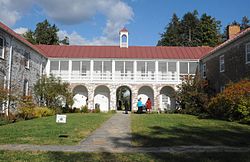United States historic place
| Blandy Experimental Farm Historic District | |
| U.S. National Register of Historic Places | |
| U.S. Historic district | |
| Virginia Landmarks Register | |
 Slave quarters Slave quarters | |
   | |
| Location | US 50/17 S side, 4 mi. W of the Shenandoah R., Boyce, Virginia |
|---|---|
| Coordinates | 39°3′36″N 78°3′53″W / 39.06000°N 78.06472°W / 39.06000; -78.06472 |
| Area | 712 acres (288 ha) |
| Built | c. 1825 (1825) |
| Architectural style | Colonial Revival, Bungalow/craftsman, Federal |
| NRHP reference No. | 92001580 |
| VLR No. | 021-0550 |
| Significant dates | |
| Added to NRHP | November 12, 1992 |
| Designated VLR | September 15, 1992 |
Blandy Experimental Farm Historic District is a national historic district located adjacent to The Tuleyries at Boyce, Clarke County, Virginia. It encompasses 15 contributing buildings, 1 contributing site, and 1 contributing structure. They include a large, two-story, brick slave's quarters built about 1825; a stone and brick stables that was later converted into a dwelling; a turn-of-the-20th-century farmhouse and its associated agricultural and domestic related outbuildings; a late-19th century vernacular hall-parlor-plan house; two historic dwelling sites; as well as orchards and fields of improved pasture.
Graham F. Blandy bequeathed 700 acres of his approximately 900-acre estate to the University of Virginia, which accepted it after his death in 1926. The University began its program of agricultural biology at Blandy in 1927, and converted part of the landscape into an arboretum. Dr. Orland E. White planted began planting the Arboretum in 1929, and upon his retirement in 1955 it was named the Orland E. White Research Arboretum. In 1986, the Virginia general assembly designated the property the State Arboretum of Virginia.
The slaves' quarters, referred to as the Quarters, was converted into laboratories and student and faculty housing. In 1941, the Quarters building was greatly enlarged with the addition of three Colonial Revival wings. This addition created a U-shaped building with the original Quarters section as the east wing. A research greenhouse was built at the same time.
It was listed on the National Register of Historic Places in 1992.
Gallery
References
- ^ "National Register Information System". National Register of Historic Places. National Park Service. July 9, 2010.
- "Virginia Landmarks Register". Virginia Department of Historic Resources. Archived from the original on September 21, 2013. Retrieved June 5, 2013.
- ^ Maral S. Kalbian and Edward Conner (April 1992). "National Register of Historic Places Inventory/Nomination: Blandy Experimental Farm Historic District" (PDF). Virginia Historic Landmarks Commission. and Accompanying photo
- "State Arboretum of Virginia". American Conifer Society. Retrieved November 5, 2021.
- "State Arboretum Of Virginia, Orland E. White Arboretum | American Public Gardens Association". www.publicgardens.org. Retrieved November 5, 2021.
External links
This article about a property in Clarke County, Virginia on the National Register of Historic Places is a stub. You can help Misplaced Pages by expanding it. |
- Farms on the National Register of Historic Places in Virginia
- Historic districts in Clarke County, Virginia
- Colonial Revival architecture in Virginia
- National Register of Historic Places in Clarke County, Virginia
- Historic districts on the National Register of Historic Places in Virginia
- Slave cabins and quarters in the United States
- University of Virginia
- Shenandoah Valley, Virginia Registered Historic Place stubs
- Clarke County, Virginia, geography stubs



